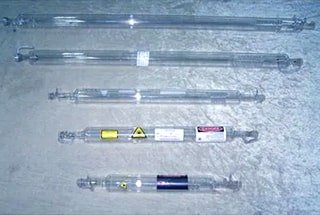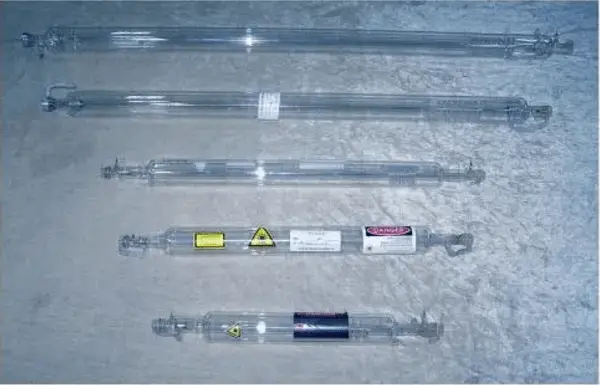
The carbon dioxide (CO 2 ) laser was invented by C. Kumar N. Patel in 1964 at Bell Laboratories. It is also known as glass laser tube and is a laser product with high continuous output power that is widely used in the textile, medical, material processing and industrial manufacturing industries. It has unique applications in the areas of packaging coding, cutting of non-metallic materials and medical aesthetics.

CO 2 laser technology advanced in the 1980s and has been widely used in industrial processing for more than two decades. It is used for cutting metals, marking and engraving various materials, welding and coating processing in industries such as automotive, shipbuilding and aerospace.
The industrial CO 2 laser operates at a wavelength of 10.64 μm and produces infrared light. Its electro-optical conversion efficiency is generally between 15% to 25%, which is a significant advantage over solid-state YAG lasers.
Due to its wavelength range, the CO2 laser beam can be effectively absorbed by a variety of materials, including steel metals, non-ferrous metals, precious metals and non-metals.
Related Reading: Ferrous vs Non-Ferrous Metals
Its range of applicable materials is even wider than that of fiber lasers.
Although fiber lasers have triggered a boom in the processing of metal materials since 2010, particularly in replacing some CO 2 cutting markets, the most significant application of current laser processing is still the processing of metal materials.
However, this has led to some misconceptions, with some people mistakenly believing that CO2 lasers are outdated and have limited usefulness.
This notion is completely incorrect.
CO2 lasers are the most technically mature, stable and reliable type of light source and have a long history of process development. They continue to be widely used in Europe and the United States for a variety of applications.
Many natural and synthetic materials have strong absorption characteristics in the 9-12 μm spectral range, which is the range covered by CO 2 lasers. This makes them ideal for materials processing and spectral analysis.
The beam properties of CO2 lasers also make them ideal for unique applications as they offer unique potential.
In this article, we will focus on several common applications of CO 2 lasers.
Processing of metal materials
Before the emergence of continuous fiber lasers, high-power CO2 lasers dominated the metal plate processing industry. I remember a manufacturer presenting a 4KW 2 CO cutting machine at an exhibition in 2012, which was capable of cutting sheets thicker than 20mm and made a huge impact on the industry at the time.
Today, fiber lasers with a power of more than 10,000 watts are used to cut ultra-thick boards. Although CO2 cutting has been mainly replaced by fiber cutting in steel cutting, but it has not completely disappeared.
Fiber lasers are easier to cut due to their finer point, but this becomes a disadvantage in welding. When it comes to joining thick sheets, high-power CO2 lasers have an advantage over fiber lasers.
Although beam oscillation was introduced a few years ago to address the limitations of fiber lasers, it still cannot match the performance of CO2 laser beams.
In addition to welding steel materials, materials such as chromium-manganese steel alloys and aluminum alloys that are difficult to weld have recently begun to appear. Some of these materials have high melting points and high light reflectivity, which requires high laser power for welding.
Material surface treatment
CO 2 lasers are mainly used for surface treatment through laser cladding. Although it can also be done with semiconductor lasers, before the advent of high-power semiconductor lasers, laser cladding was largely the domain of CO. 2 lasers.
Laser cladding is widely used in various industrial fields, such as molds, hardware, mining machinery, mechanical spindles, aerospace, offshore equipment and even new civil products.
CO 2 Lasers have a significant cost advantage over semiconductor lasers, making CO 2 laser cladding a popular option.
In metal processing, CO2 lasers face competition from fiber lasers and semiconductor lasers. As a result, future application of CO2 lasers is likely to focus on non-metallic materials, including glass, ceramics, fabric and leather, wood, plastics and polymers.

Customized applications for special areas
The nature of the CO2 laser beam offers great potential for custom special applications such as processing polymers, plastics, ceramics, etc. 2 lasers can achieve high-speed cutting of polymeric materials such as ABS, PMMA, PP and so on.
Using advanced CO 2 lasers with optimized optical patterns and optical path designs, it is possible to form a more perfect spot, reducing the heat-affected area and cutting high-quality cell phone film products such as PET protective film and display panels.
The unique advantages of CO2 laser cutting technology make it more suitable for precision film cutting than UV laser cutting technology and better meet the needs of precision processing in the IT industry.
Medical applications
In the 1990s, high-energy pulsed medical devices such as ultrapulsed CO 2 laser therapy machines emerged and were successfully applied in demanding applications, mainly in the field of laser aesthetics. This development has a very promising future.
CO 2 Laser-assisted deep sclerectomy, or CLASS, is a non-penetrating, non-subconjunctival, follicle-dependent procedure that reduces intraocular pressure through the trabecular meshwork, deep sclera, and choroidal drainage of aqueous fluid.
This innovative procedure presents few intra- and postoperative complications, is non-filtering, follicle-dependent and does not result in postoperative scars. It is simple, has a short learning curve, is easy to master and is highly effective in clinical practice.



























































